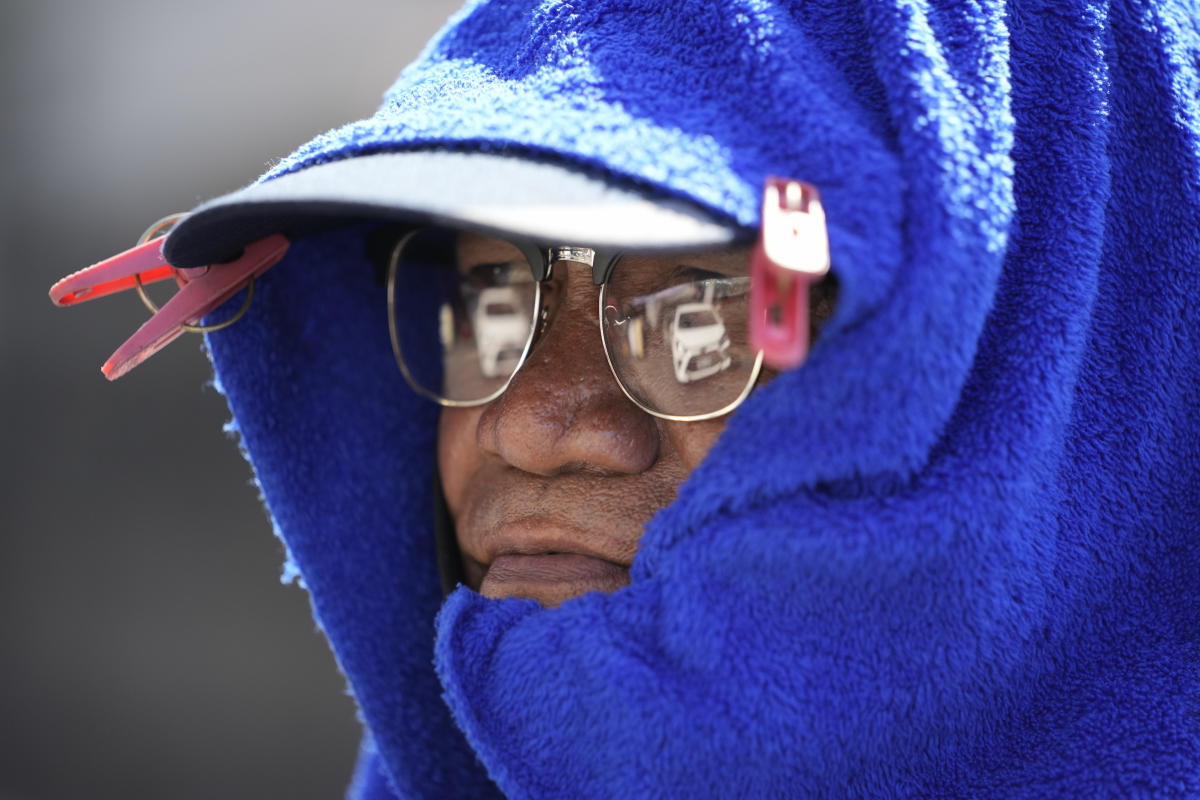
South and Southeast Asian countries are experiencing record high temperatures, leading to health risks, school closures, and warnings to stay indoors to avoid the heat wave Health officials have raised concerns for millions of children at risk of heat-related illnesses and death, with temperatures reaching as high as 43 degrees Celsius in Cambodia and over 48 degrees Celsius in Myanmar and parts of eastern India The sweltering conditions are exacerbated by humidity, making it feel even hotter than the recorded air temperatures,

Southeast Asia is experiencing a weekslong heat wave with record-high temperatures leading to school closings in countries like the Philippines and urgent health warnings. Cambodia is facing its highest temperatures in 170 years, with forecasts of up to 109 degrees Fahrenheit. Myanmar also recorded record-high temperatures, with Chauk township reaching 118.8 degrees Fahrenheit. The Philippines is severely affected by the heat wave, causing class cancelations and concerns about water shortages and crop damage.

A dangerous heat wave across Southeast Asia has led to record temperatures, school closures, and increased power demands. Thailand and the Philippines have seen record-high temperatures, with power usage hitting new peaks and prompting the purchase of liquefied natural gas. In Myanmar, power outages have worsened, while health warnings and precautions are being issued to prevent heat-related illnesses and deaths. Governments and organizations are taking various measures, such as praying for rain and sprinkling water at temples, to provide relief from the extreme heat.

Southeast Asia is the geographical south-eastern region of Asia, consisting of the regions that are situated south of China, east of the Indian subcontinent, and north-west of mainland Australia which is part of Oceania. Southeast Asia is bordered to the north by East Asia, to the west by South Asia and the Bay of Bengal, to the east by Oceania and the Pacific Ocean, and to the south by Australia and the Indian Ocean. Apart from the British Indian Ocean Territory and two out of 26 atolls of Maldives in South Asia, Maritime Southeast Asia is the only other subregion of Asia that lies partly within the Southern Hemisphere. Mainland Southeast Asia is entirely in the Northern Hemisphere. East Timor and the southern portion of Indonesia are the parts of Southeast Asia that lie south of the Equator.The region lies near the intersection of geological plates, with both heavy seismic and volcanic activities. The Sunda Plate is the main plate of the region, featuring almost all Southeast Asian countries except Myanmar, northern Thailand, northern Laos, northern Vietnam, and northern Luzon of the Philippines, while the Sunda Plate only includes western Indonesia to as far east as the Indonesian province of Bali. The mountain ranges in Myanmar, Thailand, Peninsular Malaysia and the Indonesian islands of Sumatra, Java, Bali, Lesser Sunda Islands, and Timor are part of the Alpide belt, while the islands of the Philippines and Indonesia as well as East Timor are part of the Pacific Ring of Fire. Both seismic belts meet in Indonesia, causing the region to have relatively high occurrences of earthquakes and volcanic eruptions, particularly in the Philippines and Indonesia.It covers about 4,500,000 km2 (1,700,000 sq mi), which is 8% of Eurasia and 3% of Earth's total land area. Its total population is more than 675 million, about 8.5% of the world's population. It is the third most populous geographical region in Asia after South Asia and East Asia. The region is culturally and ethnically diverse, with hundreds of languages spoken by different ethnic groups. Ten countries in the region are members of the Association of Southeast Asian Nations (ASEAN), a regional organisation established for economic, political, military, educational, and cultural integration among its members.Southeast Asia is one of the most culturally diverse regions of the world. There are many different languages and ethnicities in the region. Historically, Southeast Asia was significantly influenced by Indian, Chinese, Muslim, and colonial cultures, which became core components of the region's cultural and political institutions. Most modern Southeast Asian countries were colonized by European powers. European colonisation exploited natural resources and labour from the lands they conquered, and attempted to spread European institutions to the region. Several Southeast Asian countries were also briefly occupied by the Japanese Empire during World War II. The aftermath of World War II saw most of the region decolonised. Today, Southeast Asia is predominantly governed by independent states.

The Southeast Asian haze is a fire-related recurrent transboundary air pollution issue. Haze events, where air quality reaches hazardous levels due to high concentrations of airborne particulate matter from burning biomass, have caused adverse health, environmental and economic impacts in several countries in Southeast Asia. Caused primarily by slash-and-burn land clearing, the problem flares up every dry season to varying degrees and generally is worst between July and October and during El Niño events. Transboundary haze in Southeast Asia has been recorded since 1972 with the 1997 and 2015 events being particularly severe.Industrial-scale slash-and-burn practices to clear land for agricultural purposes are a major cause of the haze, particularly for palm oil and pulpwood production in the region. Burning land occurs as it is cheaper and faster compared to cutting and clearing using excavators or other machinery. Fires started for this purpose sometimes spread and create forest fires, worsening the problem. The high concentration of peat in soil contributes to the haze's density and high sulphur content.Fires in Indonesia (particularly South Sumatra and Riau in Sumatra, and Kalimantan in Borneo), and to a lesser extent in Malaysia and Thailand, have been identified as sources. The haze regularly has a major impact on air quality in Indonesia, Malaysia, Singapore and Brunei Darussalam; to a lesser extent and in particularly severe years, it also impacts the Philippines, Thailand, Vietnam, Cambodia and countries outside the region.Haze events have been shown to cause health issues and mortality in affected areas, and have caused disruption to economic activity and education as sectors are forced to close to minimise exposure to hazardous air. The haze also has a substantial environmental impact, being a major contributor to greenhouse gas emissions in the region and affecting wildlife and ecosystems.The haze is an international issue which has caused regional political tensions. Efforts have been made to mitigate haze events and their impacts, and some relevant frameworks for regional cooperation among ASEAN countries have been introduced. Challenges remain in implementing these, and mitigation efforts have failed to prevent haze from reoccurring.

Cambodia ( ; Khmer: កម្ពុជា; UNGEGN: Kâmpŭchéa), officially the Kingdom of Cambodia (Khmer: ព្រះរាជាណាចក្រកម្ពុជា; UNGEGN: Preăh Réachéanachâkr Kâmpŭchéa), is a country in Mainland Southeast Asia, spanning an area of 181,035 square kilometres (69,898 square miles), bordered by Thailand to the northwest, Laos to the north, Vietnam to the east, and the Gulf of Thailand to the southwest. The capital and most populous city is Phnom Penh.In 802 AD, Jayavarman II declared himself king, uniting the warring Khmer princes of Chenla under the name "Kambuja". This marked the beginning of the Khmer Empire. The Indianised kingdom facilitated the spread of first Hinduism and then Buddhism to Southeast Asia and undertook religious infrastructural projects throughout the region. In the fifteenth century, Cambodia experienced a decline of power, and in 1863, it became a protectorate of France. After a period of Japanese occupation during the Second World War, Cambodia gained independence in 1953. The Vietnam War extended into the country in 1965 via the Ho Chi Minh and Sihanouk trails. A 1970 coup installed the US-aligned Khmer Republic, which was overthrown by the Khmer Rouge in 1975. The Khmer Rouge ruled the country and carried out the Cambodian genocide from 1975 until 1979, when they were ousted in the Cambodian–Vietnamese War. The Vietnamese-occupied People's Republic of Kampuchea became the de facto government. Following the 1991 Paris Peace Accords which formally ended the war with Vietnam, Cambodia was governed by a United Nations mission (1992–93). The UN withdrew after holding elections in which around 90% of the registered voters cast ballots. The 1997 coup d'état consolidated power under Prime Minister Hun Sen and the Cambodian People's Party (CPP). While constitutionally a multi-party state, CPP dominates the political system and dissolved its main opposition party in 2017, making Cambodia a de facto one-party state.The United Nations designates Cambodia as a least developed country. Cambodia is a member of the United Nations, ASEAN, the RCEP, the East Asia Summit, the WTO, the Non-Aligned Movement and La Francophonie. Cambodia is a dialogue partner of the Shanghai Cooperation Organisation. Agriculture remains the dominant economic sector, with growth in textiles, construction, garments, and tourism leading to increased foreign investment and international trade. Cambodia is considered among the most vulnerable countries to climate change.

The ruins of a centuries-old town including a sunken church have emerged at a dam in the northern Philippines due to drought, providing a rare spectacle for residents. Locals are benefiting from ferrying tourists to the island, with one fisherman noting increased income. The old town was relocated during the 1970s dam construction, now a vital water source for the region. Extreme heat in the Philippines and Southeast Asia has led to schools closing and governments advising staying indoors. Cambodia also faced an ammunition explosion attributed to the heat, resulting in casualties.

Farmers in Luang Prabang, Laos tend their fields amidst stifling temperatures and smoke from field and hill fires, prompting financial officials of the Association of Southeast Asian Nations (ASEAN) to gather in the city to discuss securing financing for the transition to more sustainable and less polluting agriculture and energy practices.

Mainland Southeast Asia (formerly known as Indochina or the Indochinese Peninsula) is the continental portion of Southeast Asia. It lies east of the Indian subcontinent and south of Mainland China and is bordered by the Indian Ocean to the west and the Pacific Ocean to the east. It includes the countries of Cambodia, Laos, Myanmar, Thailand, Vietnam, and Peninsular Malaysia.The term Indochina (originally Indo-China) was coined in the early nineteenth century, emphasizing the historical cultural influence of Indian and Chinese civilizations on the area. The term was later adopted as the name of the colony of French Indochina (today's Cambodia, Laos, and Vietnam). Today, the term Mainland Southeast Asia, in contrast to Maritime Southeast Asia, is more commonly referenced.




ABC News

ABC News

Yahoo! News

By THE ASSOCIATED PRESS

PANORA

PANORA

Wikipedia

Wikipedia

Wikipedia

PANORA

PANORA

Wikipedia